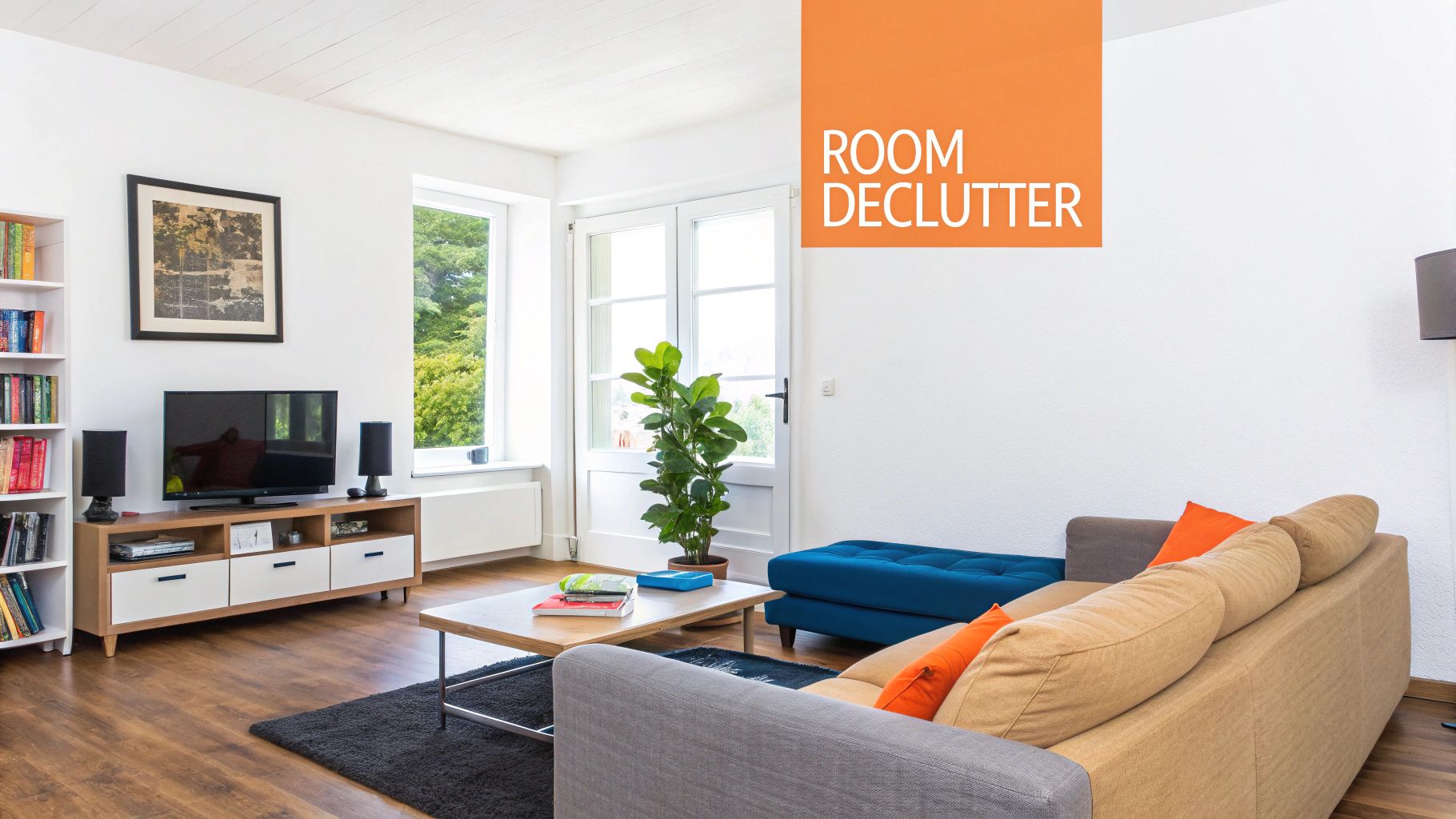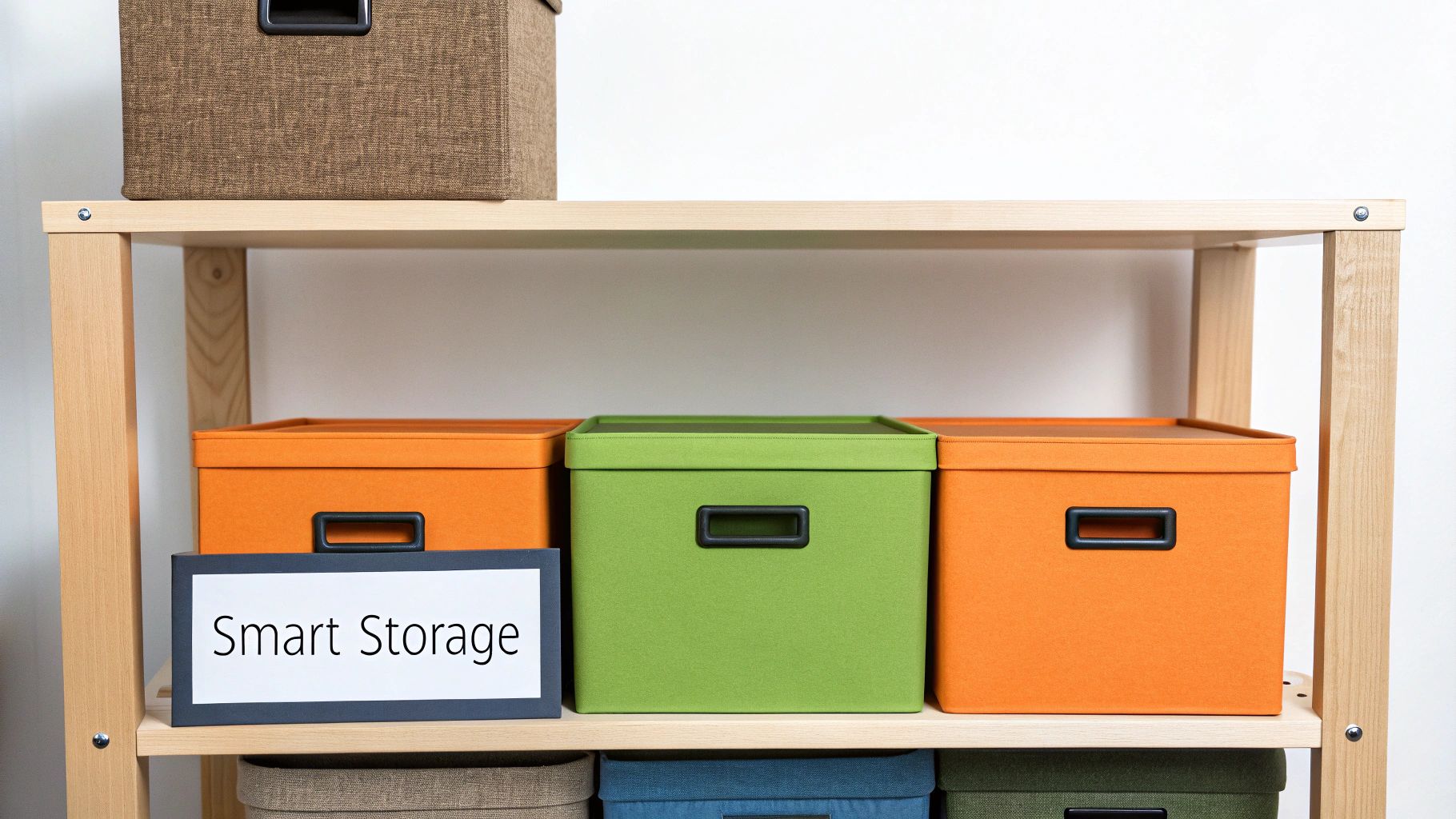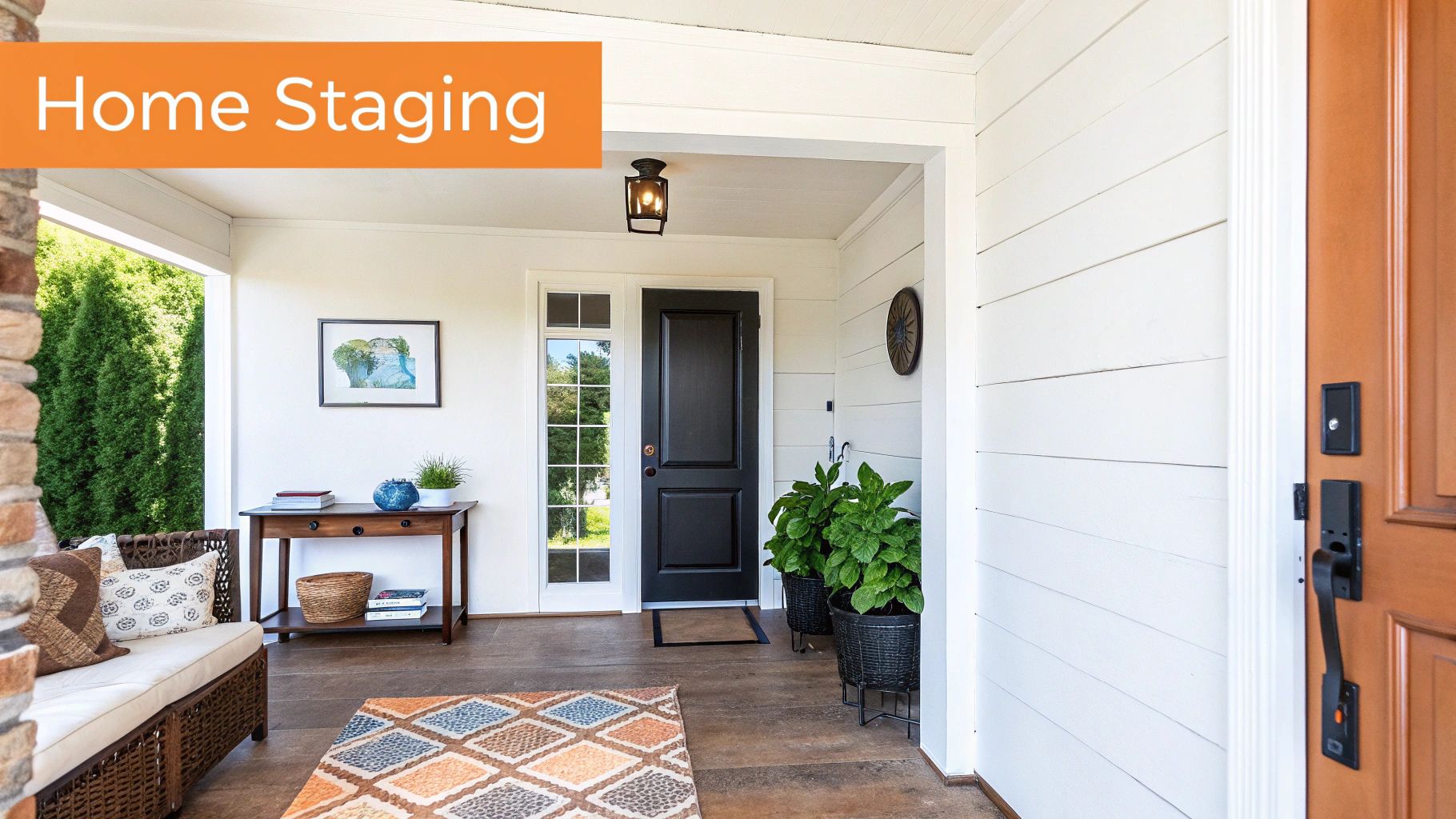Declutter House for Sale: Boost Your Curb Appeal Fast
Learn how to declutter house for sale with our expert tips. Make your home more appealing and sell faster by decluttering effectively.
Thinking about selling your home? If there's one thing you do before anything else, it should be this: declutter. I've seen it time and time again—a clean, organized house doesn't just sell faster; it often attracts much better offers. It’s hands-down the best return on investment you can get before listing.
Why Decluttering Before You Sell Is a Game-Changer
When you start to declutter your house for sale, you're not just tidying up. You're actually executing a powerful marketing strategy. This one step directly shapes how a buyer feels about your property from the moment they walk through the door. A clutter-free home does more than just look nice; it completely changes how potential buyers experience the space.
The psychology behind it is pretty straightforward. When buyers enter a home filled with personal photos, crowded countertops, and overflowing closets, they see your life, not the one they could build there. It puts up a mental wall, making it tough for them to picture where their own couch might go or how they'd use the kitchen for their family dinners. Your job is to remove that personal layer.
Create the Illusion of More Space
One of the biggest wins from a good decluttering session is how much larger it makes your home feel. Those piles of magazines, that extra armchair, and all the knick-knacks on the shelves? They visually shrink a room. Clear them out, and you instantly open up the space, letting the natural light pour in and showing off the home's actual square footage.
Think of it this way: you’re not just selling rooms; you’re selling potential. A decluttered home lets that potential shine through, making every square foot count.
Build Buyer Confidence and Trust
A well-maintained, organized home sends a clear, unspoken message to buyers: this property has been loved and cared for. It subtly suggests that if the owner has kept the inside this neat, they've probably kept up with the big stuff, too—like the plumbing, roof, and HVAC. This builds a quiet sense of trust that can make buyers feel much more confident about putting in an offer.
Before we get into the nitty-gritty, let's look at the real-world impact decluttering can have on your sale. It's not just about making things look pretty; there are tangible financial benefits.
How Decluttering Directly Impacts Your Home Sale
This table breaks down why taking the time to clear out the clutter is one of the smartest moves you can make as a seller.
| Benefit | Potential Impact |
|---|---|
| Sells Faster | A clean, staged home appeals to more buyers, leading to quicker offers. Decluttered homes can sell up to 58% faster. |
| Higher Offers | Buyers perceive a well-kept home as having higher value. This can result in a 3% to 5% increase in the final sale price. |
| Highlights Features | Without clutter, the home's best features—like hardwood floors, architectural details, or a great view—can truly stand out. |
| Reduces Buyer Objections | Clutter can hide potential issues or make rooms seem smaller and darker. A clean space removes these doubts from a buyer's mind. |
| Appeals to More People | A neutral, depersonalized space allows a wider range of buyers to mentally "move in," increasing your pool of potential offers. |
As you can see, the data backs up what real estate pros have known for years. The financial impact is real and well-documented. According to real estate expert Michael Russo, decluttered homes sell approximately 58% faster than their cluttered counterparts. Sellers also report seeing a 3% to 5% increase in the final sales price. You can find more great insights on how decluttering impacts sales on HomeLight.com. This isn't just about tidying up; it's a strategic move to get the most value out of your home.
Creating Your Decluttering Game Plan
Jumping into a whole-house declutter without a plan is a recipe for burnout. Trust me, I’ve seen it happen. You end up with piles of stuff shuffled from one room to another, feeling more overwhelmed than when you started. A solid game plan turns that chaos into a series of manageable wins, keeping you focused and moving forward.
First things first, get real with your calendar. How much time can you actually carve out for this? Maybe you can dedicate a full weekend to get the bulk of it done, or perhaps it’s an hour or two each night. Whatever it is, block it out. Treat these sessions like appointments you can’t miss. This is the only way to make progress when you're already juggling work, family, and life.
The Four-Box Method: Your Secret Weapon
To keep things moving and avoid getting stuck on sentimental items, I always recommend the four-box method. It’s simple, but it works wonders. As you go through an area, every single thing you pick up must go into one of four piles or boxes. No exceptions.
- Keep: These are the non-negotiables. The things you love, use, and absolutely want in your next home.
- Donate/Sell: Items that are still in good shape but don't have a place in your life anymore. One person's clutter is another's treasure!
- Store: Think seasonal decorations, sentimental items that aren't for display, or bulky furniture that makes a room feel small. These things need to go into a storage unit or be neatly packed away in the garage or attic.
- Trash/Recycle: Anything that's broken, expired, or just plain junk. Be ruthless here.
This forces you to make a decision on the spot, which is the key to clearing out the clutter instead of just rearranging it. If you're feeling overwhelmed by the sheer volume of your stuff, you're not alone. A recent survey found that 54% of Americans feel stressed by their clutter, and it's no wonder when the average home can contain up to 300,000 items.
This visual guide breaks down the process beautifully. It’s all about making a decision and then acting on it.

As you can see, the crucial part is getting the "Donate," "Store," and "Trash" items out of the house before you even think about organizing what's left. That's when you really start to feel the space open up.
The secret to a successful and less stressful declutter is breaking the massive job into smaller, concrete steps. A structured plan like this keeps you in control and prevents that all-too-common decision fatigue.
While you're in planning mode, looking at a comprehensive moving house checklist can help you see how decluttering fits into the bigger picture of your move. For a detailed guide to get your home market-ready, be sure to grab our complete prepare home for sale checklist here: https://pedra.so/blog/prepare-home-for-sale-checklist. It’s the perfect partner to your decluttering plan.
Your Room-by-Room Guide to a Buyer-Ready Home

Alright, with a plan in hand, it's time to get down to business and tackle the house one room at a time. The trick is to focus on the areas that pack the biggest punch for a buyer's first impression. You’re not just cleaning; you're merchandising your home. Think of it as creating a sense of space, light, and possibility in every corner.
We’ll start with the high-traffic zones that buyers inspect the closest: the living room, kitchen, and bedrooms. The goal is simple: create a clean, neutral canvas that lets buyers imagine their future, not see your past.
The Living Room: An Open Invitation
The living room is often the first real interior space a buyer experiences. It sets the tone for the entire tour, so you want to create an immediate feeling of spaciousness and warmth.
Take a hard look at the furniture. Most of us accumulate more than we need, and bulky pieces can make even a large room feel cramped. Pull out any extra chairs, that oversized ottoman, or unnecessary side tables. You're aiming for clear, easy walking paths that show off the room's natural flow. After that, it’s all about the surfaces.
Living Room Declutter Checklist:
- Wipe the slate clean on flat surfaces. Coffee tables, end tables, and mantels should be almost bare. A single art book or a simple, tasteful vase is plenty.
- Edit the bookshelves. I tell my clients to remove at least half of what's on their shelves. This creates visual breathing room and makes the storage look generous.
- Box up personal décor. Family photos, your kids' art projects, and specific collections need to be packed away. Buyers need to see a blank slate they can project their own lives onto.
- Get a handle on media clutter. Tidy up all wires and cables. Store away those stacks of DVDs, video games, and extra remotes.
A buyer should walk into your living room and think, “Wow, this feels so open and bright,” not, “Where would I even put my couch?” Every item you remove helps them get closer to that feeling.
The Kitchen: A Clean Slate
For many buyers, the kitchen is everything. It's the heart of the home, and they're looking for function, storage, and a clean, modern vibe. When you declutter your house for sale, the kitchen is where you have to be absolutely ruthless.
Even everyday items left on the counter can signal a lack of space. Your mission is to get those counters as empty as humanly possible. This one move can dramatically change how big and useful your kitchen feels.
Kitchen Declutter Checklist:
- Clear the countertops completely. The toaster, coffee maker, knife block, and utensil crock all need to be stored away. A single decorative piece, like a bowl of fresh lemons, is the only thing that should be left out.
- Organize the pantry and cabinets. Buyers will open your cabinets. Stack dishes neatly and group similar food items. Toss any expired food. This shows them you have more than enough storage.
- Tackle the fridge. Get rid of all the magnets, photos, and calendars on the door. While you're at it, give the inside a good cleaning, too.
To really get your kitchen ready, implementing effective kitchen cabinet storage solutions can be a game-changer. Smart organization makes existing storage feel twice as large.
Bedrooms: A Peaceful Retreat
Bedrooms should feel like a serene escape, not a command center for daily life. The goal is to transform them from your personal space into a tranquil, hotel-like room. That means getting rid of anything that feels too personal or creates visual noise.
The focus here is on creating a calm atmosphere and, just as importantly, highlighting the storage space. An overstuffed closet is a huge red flag for buyers; it immediately suggests the home doesn't have enough room for their things.
Bedroom Declutter Checklist:
- Clear off all surfaces. Nightstands and dressers should be completely clear, except for maybe a lamp and a single book.
- Declutter closets. This is non-negotiable. Aim to have your closets at least 30-50% empty. Pack up all out-of-season clothing and shoes. Investing in matching hangers makes a world of difference.
- Remove personal items. Take down family photos and any themed décor that is specific to your tastes.
- Simplify the bed. Use neutral, inviting bedding. A few decorative pillows are fine, but don't overdo it.
By working through these high-impact rooms methodically, you’re strategically setting the stage to impress. Every cleared surface and organized closet is a step toward a faster, more successful sale.
Smart Ways to Handle Your Unwanted Items

Alright, you’ve sorted through every room and now you're faced with piles of stuff you no longer need. This is where the magic happens. The final step is all about clearing out that clutter for good, turning what feels like a messy chore into a clear, manageable—and maybe even profitable—task. How you approach this really depends on what you're trying to achieve. Are you looking to make some quick cash, get it done as fast as possible, or be more eco-friendly?
The "Donate" pile is usually the biggest and, frankly, the easiest to handle. You're not alone in this. A recent survey showed that giving items to thrift stores is the most common way people get rid of clutter, with 67.1% of homeowners choosing this option. Other popular methods are curbside pickup (48.3%) and classic yard sales (25.1%). If you're curious, you can explore the complete survey results from Budget Dumpster to see how your habits compare.
Pro Tip: Always ask for a donation receipt! Many charities will provide one, and it can come in handy for a potential tax deduction. It’s a simple step that might save you some money down the road.
Turning Clutter into Cash
If making a little extra money is high on your list, it's time to focus on your "Sell" pile. Good-quality furniture, working electronics, and designer clothes can actually bring in a decent amount, but you have to sell them in the right place.
- Facebook Marketplace & OfferUp: I’ve found these are brilliant for bulky items like couches, tables, or that treadmill you never use. It’s all local, so you skip the shipping nightmare, and buyers come straight to you.
- Poshmark & Mercari: If you have brand-name clothes, shoes, or accessories, these apps are your best bet. They have a huge, built-in audience of people hunting for secondhand treasures.
- A Good Old-Fashioned Garage Sale: Don't underestimate the power of a garage sale, especially if you have a ton of smaller items. Advertise it well, price things to sell, and be ready to bargain. It’s a great way to get rid of a lot of stuff in a single weekend.
A little strategic thinking here can actually turn your hard work into a nice little side hustle. Every bit helps, whether it's covering moving costs or funding a few upgrades for your new place.
When You Need to Call for Backup
Sometimes, the sheer amount of stuff is just overwhelming. If you're dealing with heaps of clutter, old broken furniture, or even leftover debris from a small renovation, renting a small dumpster can be a lifesaver.
It might sound extreme, but it simplifies the entire disposal process, especially when you’re trying to declutter a house for sale and the clock is ticking.
Ultimately, the goal is to create a clean slate that lets buyers see the potential. Once you’ve cleared everything out, you might be left with an empty room, wondering what's next. Tools and examples can give you some great ideas on how to stage it. Take a look at these examples of decluttering an empty room to prepare it for buyers to see what’s possible. Making smart choices now about what to do with your unwanted items will make that final push to list your home feel so much easier.
Staging Your Space to Help Buyers Feel at Home

Once the clutter is gone, it's time to shift your mindset. You're no longer just tidying up; you're merchandising a product. That means depersonalizing your space so buyers can see it as their future home, not your current one.
It’s a subtle but powerful distinction. The goal is to create a welcoming, neutral canvas where a potential buyer's imagination can run wild. They should be picturing their own furniture in the living room, not wondering about the story behind your family vacation photos.
This is where you have to be a little ruthless. The very things that make a house feel like your home—family photos, your kids’ drawings on the fridge, that quirky collection you’ve curated for years—are the first things that need to be packed away. They create a strong personal narrative that can, unfortunately, get in the way of a buyer forming their own emotional connection.
Creating a Neutral and Inviting Atmosphere
Think of it like checking into a high-end boutique hotel. The space is stylish, immaculate, and inviting, but you'd never know who stayed there the night before. That's the vibe you want. It lets the home's best features—the great natural light, the beautiful floors, the spacious layout—truly shine.
Here’s how to get there:
- Swap Out Photos: Take down all personal and family pictures. Replace them with simple, neutral art or even a few well-placed mirrors to make the room feel bigger and brighter.
- Store Collections: Your prized vinyl records or antique teacups are fantastic, but they cater to a specific taste. Buyers should be admiring the built-in shelving, not your collection. Box it all up for your next home.
- Tone Down Bold Decor: That vibrant accent wall you love might be a dealbreaker for someone else. A weekend and a can of paint in a soft, neutral shade like greige, warm white, or soft beige can make a world of difference.
The real secret is to help buyers see the bones of the house—the walls, the windows, the layout—not the stuff you've filled it with. When they can mentally move their own couch in, you're on the right track.
Don't forget to look down, either. Scuffed or worn-out flooring can kill the mood instantly. It’s often worth exploring the benefits of having your floors restored; a fresh finish can dramatically lift the entire feel of a room.
Modern Tools to Perfect Your Staging
Getting that professionally staged look doesn't have to be a game of trial and error anymore. You can actually visualize the perfect setup before you lift a single heavy box.
Virtual staging tools like Pedra, for example, let you upload a photo of your empty (or decluttered) room and experiment with different furniture layouts and decor. See what that minimalist sofa looks like, or test out a different color palette, all from your computer. It’s a brilliant way to make smart, effective decisions without the back-breaking work. If you want to learn more, our guide on essential home staging tips has even more great ideas: https://pedra.so/blog/home-staging-tips.
Ultimately, great staging is about selling a lifestyle. By peeling back the personal layers and presenting a clean, stylish, and welcoming home, you’re not just selling a property. You're selling a dream, and that’s what gets offers on the table.
Common Questions About Decluttering to Sell
Even with the best plan in hand, you're going to have questions as you start decluttering your house to sell. It's a massive job, and it’s perfectly normal to feel a bit lost at times.
Let's tackle some of the most common questions I hear from homeowners. Think of this as your quick-reference guide for those moments when you need a clear, straightforward answer to keep moving forward.
How Much Should I Actually Declutter Before Selling?
This is the big one, and the honest answer is almost always more than you think. A solid goal is to remove at least 30-50% of your personal items and furniture. No, that's not a typo. The point isn't to erase all signs of life, but to create a powerful feeling of spaciousness.
Your guiding principle should be making every single room feel bigger and brighter. Here's where to focus:
- Clear all flat surfaces. Countertops, coffee tables, dressers—get them as close to empty as possible.
- Thin out your shelves. Whether it's books or collectibles, you want to create visual "breathing room," not a crowded display.
- Make closets look spacious. Buyers will open them. A closet that's only half to two-thirds full looks generous and suggests there's plenty of storage.
Here’s a simple rule professional stagers live by: if you haven't used an item in the past year, it’s time to pack it, sell it, or let it go.
An uncluttered home doesn't just look better; it feels better. It gives buyers the mental space to imagine their own belongings in the room, which is a crucial step toward them making an offer.
Should I Hire a Professional Organizer to Help?
Bringing in an expert really comes down to your situation. If you're looking at rooms filled with decades of belongings and feel completely paralyzed, a professional organizer or stager can be worth their weight in gold. Same goes if you're just slammed for time with work and family.
Their real value is a fresh, objective perspective. A pro has no emotional attachment to your grandfather's old chair or your kids' art projects, so they can make quick, effective decisions that get the job done efficiently. The cost is an investment that often comes back to you in the form of a quicker sale or a better offer.
Where Do I Put All the Stuff I Want to Keep?
You’ve sorted your piles, and now you have a mountain of things you definitely want for your next home, but they’re just creating clutter right now. The best solution, hands down, is a temporary, off-site storage unit.
I know it's tempting, but please resist the urge to just pile everything into the garage or basement. Storage is a huge selling point, and when buyers see a garage packed to the rafters, it immediately sends a message: "this house doesn't have enough space." A clean, organized garage makes a far better impression than one that's basically a self-storage unit.
Feeling stuck trying to picture what your rooms could look like? Pedra can show you. Our AI tools can instantly declutter photos of your rooms, revealing their true potential and helping you create amazing visuals for your listing. See how it works at pedra.so.

Related Posts
Top 7 AI Room Decoration Tools for 2025
Discover the best AI room decoration software for 2025. Our review compares top tools to help you de...
9 Curb Appeal Ideas on a Budget That Actually Work (2025)
Transform your home's exterior with our top curb appeal ideas on a budget. Get easy, high-impact tip...
10 Essential Curb Appeal Improvements for 2025
Discover 10 essential curb appeal improvements to boost property value. This guide for real estate p...